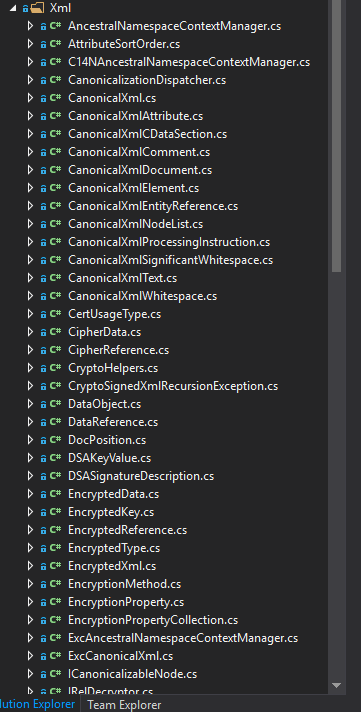Using .net Framework sources for better debugging
Over the last couple of weeks, we've been working on changes to our SAML 2.0 Authentication on Stack Overflow Enterprise. This was required to better support scenarios around signing and encrypting SAML Requests and Responses, and as such, a lot of the work was centered around XML Security, specifically the SignedXml and EncryptedXml classes.
Now, one thing I can say for sure about SAML 2.0 is that every Identity Provider implements it slightly differently, causing XML Validation errors or CryptographicExceptions somewhere deep in the code. So, how can we properly debug and fix this?
The first option is to Enable Symbol Server support in Visual Studio. This gives you .pdbs for .net Framework code, but because the Framework is compiled in Release mode, some code is inlined or otherwise rewritten to no longer match the exact source, which makes following variables and even call stacks really hard the deeper you go.
Another option is to check out the .net Framework Reference Source, also available on the easy to remember http://sourceof.net. This is the actual source code of the .net Framework, which allows at least reading through it to see what's actually going on, at least until you hit any native/external code. You can even download the sources, which not only allows you to view it in Visual Studio, but it also allows you to compare implementations across Framework versions to see if anything changed. (The code on the website is always only for the latest Framework, which is 4.7.1 at the time of writing. If I need to see how something was implemented in 4.6.2, I need to download the sources)

Another thing that we can do with the reference sources is to put them into our project, change namespaces to avoid ambiguity, and then use our private copies of the implementation.
This is a huge help for several reasons:
- We can step through actual code, no compiler symbols or weird abstractions, it's actual code.
- Since we can compile in Debug mode, we don't have to worry about optimizations making the debug experience much harder.
- Breakpoints work properly, including conditional ones.
- If we have a hypothesis about a cause of or fix for an issue, we can make source code changes to verify.
Now, there are two problems with Framework Sources. First off, because Framework code can refer to protected and internal methods, we might have to either copy a massive amount of supporting code, or implement workarounds to call those methods that are inaccessible to us (there are 79 files in my private copy of SignedXml/EncryptedXml). But the real showstopper is that the license doesn't allow us to ship Framework code, as it's only licensed for reference use. So if I found a way to fix an issue, I need to see how I can make this work on our side of the code, using the actual .net Framework classes.
Now, if we really don't find a way to solve this issue without needing to modify Framework code, a possible option are the .NET Core Libraries (CoreFX) sources, because that code is MIT Licensed. It's a subset of the .net Framework, but due to the license, anything that's there can be used, modified, and shipped by us. This is a bit of a last resort, but can be preferable to worse workarounds. I can not understate how awesome it is that Microsoft releases so much code under such a permissible license. It not only makes our life so much easier, but in turn it benefits our customers by providing a better product.
In the end, we could resolve all issues we've seen without having to modify framework code after why understood exactly where (and why!) something was failing, and our SAML 2.0 implementation got a whole lot better because of the availability of the source code.